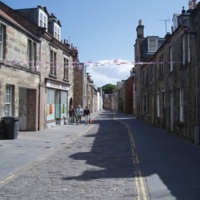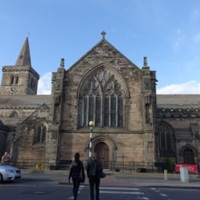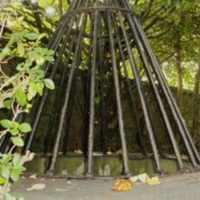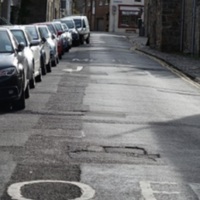A Virtual Exhibition of Medieval St Andrews
中世纪圣安德鲁斯的虚拟展示
Title
A Virtual Exhibition of Medieval St Andrews
中世纪圣安德鲁斯的虚拟展示
中世纪圣安德鲁斯的虚拟展示
Description
Text description, images, audios, videos and location information of historical sites in St Andrews. The descriptions are written in English and Chinese.
这是一个圣安德鲁斯历史遗迹的集合,包含了历史遗迹的文本信息,位置信息,图片,音频以及视频,文本信息包含中英文双语。
这是一个圣安德鲁斯历史遗迹的集合,包含了历史遗迹的文本信息,位置信息,图片,音频以及视频,文本信息包含中英文双语。
Date
Jun 4, 2015
Language
English/中文
Collection Items
Church of St Mary, Kirk Hill
圣玛丽教堂,科克山
Kirk Hill (or Kirk Heugh as it is sometimes called) has a long history of human activity. Archaeologists have found evidence of prehistoric burials at this site, perhaps dating from as long ago as 500 B.C. There are also some signs of early metal…
St Rule's Church
圣鲁尔教堂
The small building now known as St Rule's Church was once St Andrews' main cathedral. It was probably built in the early twelfth century, perhaps by workmen from northern England. The church is in the Romanesque (or Norman) style that was then…
St Andrews Cathedral
圣安德鲁斯大教堂
St Andrews Cathedral was once the most important church in Scotland. It was the base for the country's senior bishopric and housed the relics of St Andrew (the nation's patron saint). For many centuries St Andrews Cathedral was the largest building…
Blackfriars
黑衣修士修道院
The ruins at Blackfriars are all that remain of St Andrews' Dominican friary. The Dominicans (also known as the Black Friars because of the colour of their cloaks) are a Catholic religious order founded in France in the thirteenth century. They were…
Cathedral Cloister and Priory Buildings
大教堂回廊和修道院建筑
Like many medieval English and continental cathedrals, St Andrews had an associated monastery. In the mid-twelfth century a priory of Augustinian canons was founded at St Andrews Cathedral (displacing an earlier community of Celtic holy men). The…
The Pends
拱道
At the east end of South Street there is a pair of fourteenth-century arches known as "the Pends". These were part of a gateway to the walled enclosure surrounding St Andrews Cathedral. During the Middle Ages many cathedrals and monasteries had…
St Salvator's College Chapel and Tower
圣萨尔瓦托学院礼拜堂和塔
St Salvator's Chapel is one of St Andrews University's two surviving medieval chapels (the other is St Leonard's Chapel on South Street). It was built in the 1450s by Bishop James Kennedy as a place of worship for the members of his new College of St…
St Leonard's Chapel
圣伦纳德礼拜堂
The origins of St Leonard's may go back as far as the twelfth century, when an (unnamed) hospital was referred to in a document concerning St Andrews Cathedral. By the mid thirteenth century a hospital dedicated to St Leonard was firmly established…
Tolbooth
镇政府
Outlined in the paving on Market Street is the location of St Andrews' former tolbooth (the Scottish equivalent of a town hall). We do not know precisely when St Andrews’ tolbooth was built, but recent archaeological excavation suggests the site has…
St Mary's College
圣玛丽学院
The site of St Mary's College was one of the first properties acquired by the University of St Andrews. When the university was founded in 1413 it had no buildings of its own and lecturers taught in borrowed rooms. However, in 1419 a college…
St Andrews Castle
圣安德鲁斯城堡
St Andrews Castle was the home of the bishops of St Andrews. The site has been fortified since at least the 1190s. However, most of what we see today was built between 1380 and 1560. St Andrews Castle was the scene of major events in Scottish…
Castlecliffe
城堡悬崖
The area now occupied by the visitor centre for St Andrews Castle has seen a lot of different uses. During the late 1980s archaeologists found evidence of a fourteenth-century tannery on this site. Tanners converted animal skins into leather by…
Cathedral Precinct
大教堂区域
During the Middle Ages St Andrews Cathedral was surrounded by buildings. There was accommodation for the canons who served the cathedral, housing for pilgrims who visited St Andrew's shrine, barns for storing the food and produce given to the church,…
Mercat Cross
麦卡特十字
Markets have been held in St Andrews since at least the late twelfth century. In the 1190s it was decided that St Andrews' market-place should be on "the land of Lambinus" - an open space roughly where the wide section of Market Street is today. As…
Mercat Port
市场门
The medieval city of St Andrews was much smaller than the modern settlement. In the late Middle Ages Market Street had housing only as far west as the current road junction with Greyfriars Gardens. An inlaid slab in the pavement nearby marks the site…
Narrow Mercat Gait
窄市场街
The eastern end of Market Street is much narrower than the rest of the street. During the late Middle Ages this area was called the Narrow Mercat Gait. It is thought that the Narrow Mercat Gait was originally an alleyway running between the…
Holy Trinity Church
圣三一教堂
Holy Trinity Church was for many years the main place of worship for St Andrews' ordinary residents. It was built in the early fifteenth century, near the residential and trading centre of St Andrews. During the late Middle Ages Holy Trinity was…
West Port
西门
During the late Middle Ages there were gateways across all the main roads into St Andrews. These marked the entries to the city and formed a public reminder of the transition from the countryside to the urban area of St Andrews (which, like other…
Greyfriars
方济会
The properties on Greyfriars Gardens were built during the nineteenth century, as part of the Victorian expansion of St Andrews. However, the name "Greyfriars" reflects the earlier history of this site. In 1458 Bishop James Kennedy founded a…
Fish Gait
鱼街
The road leading from North Street to the Castle used to be called Fish Gait. The early history of the road is unclear. It has been suggested that Fish Gait is one of the oldest streets in St Andrews. However, archaeological excavations in the 1980s…







